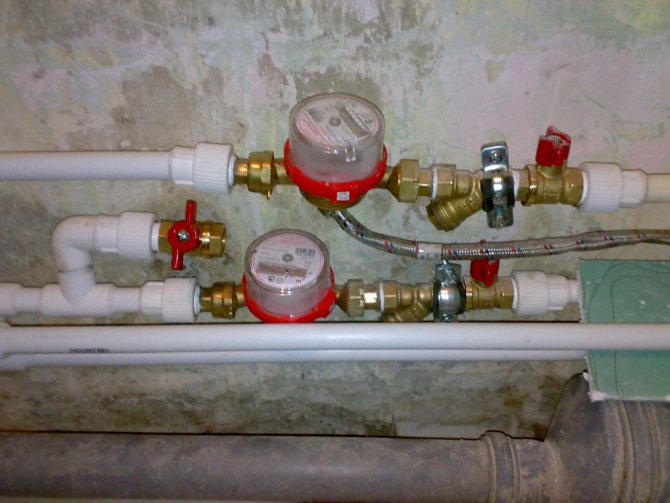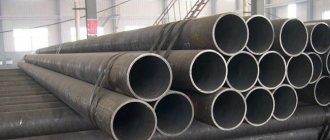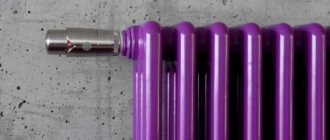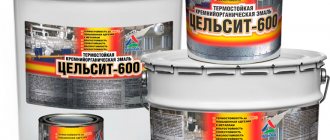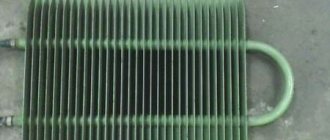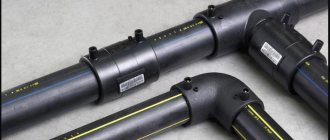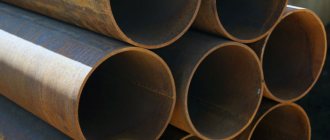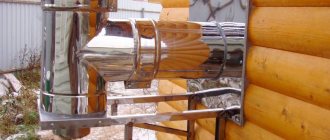The need to paint pipes may arise not only if the material from which they are made requires it. The color of metal or plastic may not match the interior of the room. Pipelines differ by type of use, by material, by location. Depending on this, a dye with certain properties is chosen. It is necessary to take into account both the base of the paint and additional fillers. By the type of use, the pipeline can be:
- for cold water supply;
- GVH pipes;
- gas pipeline.
For the realization of certain purposes, metal or plastic pipes are used. The dye is selected according to the material.
The pipeline can be located indoors, outdoors, in water, underground.
It is necessary to take into account the aggressive environment in which the pipes are located:
- evaporation of chemical vapors,
- hot shop,
- production using low temperatures.
Latex-based enamels are most often used: acrylic, acrylate, latex dyes. They are waterproof, do not fade, form an anti-corrosion and elastic film on the surface. Manufacturers offer a wide range of colors. They are produced in the form of a dispersion powder. It is diluted with water to form an emulsion. The paints are odorless and dry quickly.
Advantages of a polypropylene pipe
Polypropylene has a number of advantages, including:
- heat resistance (in connection with which they are used to supply both cold and hot water);
- wear resistance;
- density and strength;
- not susceptible to corrosion.
Plastic elements can be made in different colors. To do this, a dye is immediately added to the plastic. But what if you bought white plastic materials and you couldn't hide them?
In this case, there is a way out - to paint the plastic pipes with paint that would fit into the interior of the room. For example, many people decide to paint such elements to match the color of the walls to make them less visible. Others, on the contrary, focus on painted pipes. For example, you can paint them green and then wrap them with artificial grape leaves. Painted in this way, they will look like the trunk of a grape tree. But this option is suitable, of course, only for the kitchen.
DESIGN PRESTIGE LLC
Painting of plastic pipes
There is no need to paint plastic pipes, they are not afraid of external influences, except for ultraviolet radiation. The application of the coating can be justified by aesthetic considerations, because typical colors (white, gray, less often beige and green) do not always and not everyone satisfy in open areas. Manufacturers offer, as for metal, special primers for plastics. However, in all honesty, there is little sense in them and you can completely do without it. Polymer products should be painted with non-aggressive compounds, exclude brands NTs, ML and those for which acetone, 646 and the like are solvents.
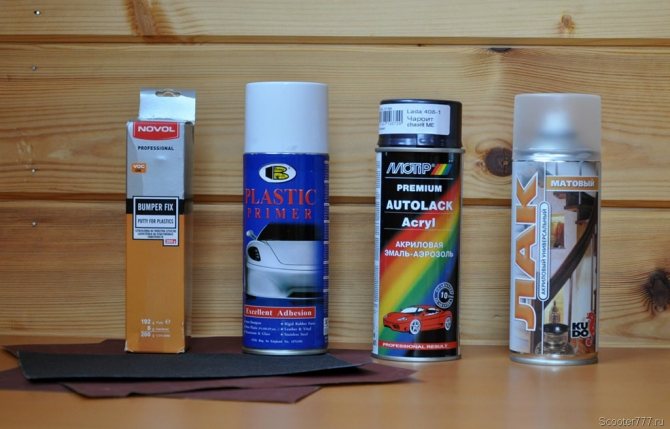
Materials for painting plastic pipes.
The best choice is any aqueous formulation, including for mineral surfaces: dispersed, emulsion, acrylic, organosilicon. Conventional water-soluble wall paints will wear off with constant hygienic cleaning, but there are those intended for joinery, they are resistant, wash well, have good adhesion. Sufficiently neutral acrylic and pentaphthalic, based on white spirit, are suitable.
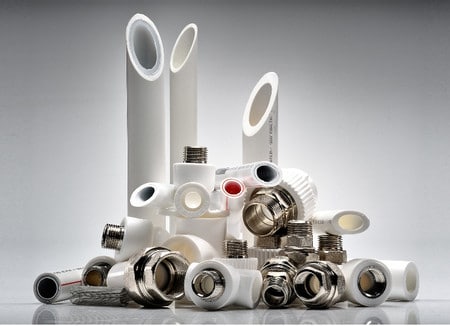

Plastic pipes do not need painting, 90% are standard white or gray
Methods for painting polypropylene pipes
DESIGN PRESTIGE LLC
Painting with ordinary paint for metal
People write a lot about this method on the forums, and the reviews are mostly good.
The advantages of using the method are:
- availability. Finding paint for metal is the easiest way. It is very widely used for household purposes. And if you're lucky, you can find it at home in the pantry, because when painting batteries, exactly the same paint is used;
- low price;
- ease of application. No base needed, no need to rub down the pipe - just apply paint and let it dry.
But there are also disadvantages when painting with this method:
- Not as intended. When paint for metal was created, no one even heard of polypropylene pipes. That is, it has not been studied exactly how it acts on plastic. Although this method of painting plastic pipes is still very popular.
- Smell. The paint has a rather nasty and pungent smell, so it is necessary to paint with an open window. Otherwise, you will get at least mild chemical poisoning (or intoxication from chemicals).
- Density. This paint has a fairly thick consistency. But in no case should it be diluted with water! This consistency can cause small drips on the pipe, so you need to act carefully and carefully spread it over the entire surface of the pipe.
Painting with regular wall paint
But in this case, there are slightly more disadvantages:
- instability... Such paint is not designed for heating, and if pipes are used for heating, this will lead to negative consequences;
- destruction... Do not use water-based paint, as it will destroy the top layer of the pipe itself (cause corrosion). If, nevertheless, paint on water is used, then it is imperative to apply a base to the pipe - alkyd enamel. This will prevent negative effects.
But there are also pluses:
- stealth. The pipe is painted with the same paint as the walls, and practically merges with it. This makes it as invisible as possible;
- versatility;
- diversity. Wall paint comes in all kinds of flower and shades;
- usual work.
Painting with a pre-primer
This method is, rather, not in the paint itself, but in the base under it. Often a special spray is used for the primer. It will protect the pipe. This primer is often used in car dealerships and tire changers. Therefore, you can find it there. Having processed the necessary object, you need to give it time to dry. And then you can paint the element with any paint. The main rule that should be followed when choosing it is heat resistance. It is indicated on the label of any paint.
Painting with acrylic paint
Acrylic paint is considered the softest for coating polypropylene pipes. The solvent in it is not hazardous to plastic, unlike many other paints.
The positive features of this choice are:
- safety - does not damage the material;
- wide range of colors;
- ease of application;
- lack of a pungent smell.
Types of pipe paint
The pipe can be painted with anything. For example, the same painting of a cold water riser is performed with oil paint, and nitro enamel, and water emulsion, and any other medium. Only if you choose "any other medium", then the effect of staining the pipe can be anything you like: positive, neutral or negative. Therefore, pipes are painted only with the correct paints. And which paint will be "correct" - depends on the specific pipe and specific operating conditions.
For external pipelines, red lead is the best option.... This paint oxidizes the outer metal layer of the pipe to form a hard lead-iron oxide film. Such a film prevents further oxidation of steel both under the influence of the atmosphere and under the influence of water.
The enamel group of coloring media will not be the worst option for pipe paint.
This type of paint dries in 24 hours, forming a very resistant film on the metal surface. Enamel paints can withstand temperature drops from -50 to 60 degrees Celsius.
The average service life of the enamel coating is 5-8 years. Well, if you increase the number of layers, then the service life of the painted surface will increase significantly. Moreover, the consumption of paint for each layer will only decrease - the surface painted with the emulsion no longer absorbs the paint.
Internal surfaces are treated with paints with slightly different physical and chemical properties. There can be no talk of 100-degree temperature drops in the room. Direct exposure to water is also rare.
Therefore, oil paint or water emulsion is used as the main option for a pipe inside the house.
The latter option is attractive because of its complete absence of odor. After all, water emulsion involves the dissolution of the coloring pigment in water, and not in acetone or drying oil. And the source of the intoxicating smell of paint is precisely the solvent.
Painting hot surfaces
For hot surfaces, only oil paint is ideal. She tolerates quite high temperatures. When heated above 250-300 degrees Celsius, oil paint turns into real armor, covering the entire surface of the pipe with a strong crust.
In addition, oil paint can last for 10 and 15 years on hot surfaces. Just match the color of the dye. Indeed, under the influence of a hot environment, it burns out in a matter of years and bright colors are not appropriate here.
How to paint pipes?
Pipe painting does not require any special skills. Even a beginner in the field of painting can do this business. However, there are some subtleties in this procedure.
Therefore, before painting a pipe, you better listen to the following guidelines:
- do not paint the pipe over the remaining layer of old paint. It is better to remove all traces of the work of previous painters to the surface of the metal. As a last resort, it is allowed to leave intact those layers that are no longer separated from the pipe surface. However, all bubbles, scales and loose areas must be removed mercilessly.
- wait a little while painting the cold pipe. After all, moisture - condensate - always settles on the surface of such a pipeline.
Before painting, the pipe must be heated to room temperature and blotted with a cloth until dry.
- always prime the pipe surface. Yes, you also have to buy a primer for this. But when you see how much paint can go to a pipe without a primer, you will simply be horrified! So priming is not an additional cost, but one of the savings!
- use different tools. Don't stop at one option: just a brush or just a roller. After all, the same paint for hot pipes is best applied not with these tools, but with a spray gun. So just buy a brush, a roller and a spray bottle. In any case, they will be useful to you. After all, you are not painting the pipe for the last time.
- apply layers in different directions. That is, if you applied the first layer on the movement of fluid in the pipe, then the second layer must be applied across the flow of the transported medium.
- do not start painting without calculating the volume of the paint itself. Especially if you use a non-standard color scheme obtained by mixing several colors.
Based on the last point, the most important intermediate stage, preceding the staining procedure, is the calculation of the volume of the purchased dye. Therefore, further we will study this moment in a little more detail.
Varieties of compositions
As mentioned earlier, for each type of pipeline, its own paint must be selected:
- The most capricious in this regard is the distribution of heating and radiators;
- Behind them you can put external pipelines;
- The least capricious, but also requires attention, plastic wiring.
Coloring heating wiring
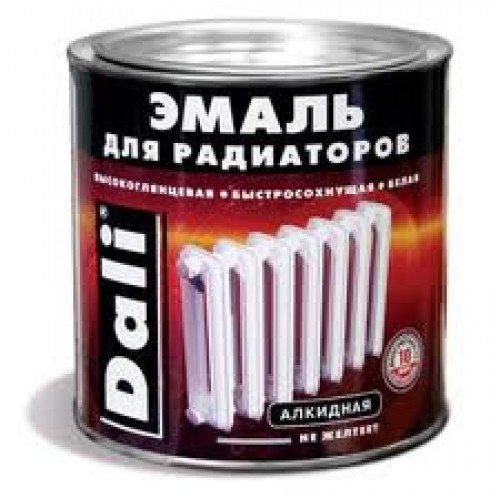

Alkyd enamel.
- Currently, alkyd compositions are rightfully considered the first in popularity here.... They form a strong, stable covering film, which has quite good elasticity indicators, which is very important for surfaces subject to thermal expansion. Alkyd enamels have an enviable glossy shine, but since they are based on an organic solvent, they smell strong during application and require good ventilation.
- Water-based or water-dispersed mixtures theoretically can be used... These paints fit well, have no odor, but they are not durable, plus they cannot be used everywhere for a heating system, since they have a heat-insulating effect.
- Acrylic and acrylate enamels are a relatively new product on the market and during this time they have won a lot of fans.... They can be either matte or glossy. They have high abrasion rates and good heat capacity. The coating itself is a thin, elastic layer of plastic polymer. The only serious drawback of these enamels is the high price.
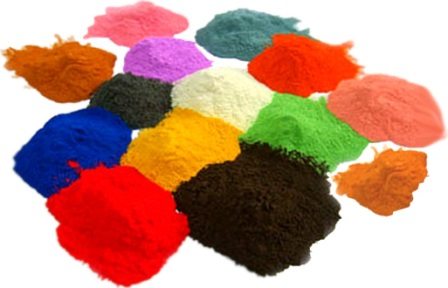

Powder dyes.
Important: no matter what composition you decide to buy, first of all you need to pay attention to the heat resistance of the paint for decoration. The instruction on such paints should contain data on the lower and upper temperature thresholds for operation, plus an indication of which base the composition is intended for.
The video in this article shows a special heat-resistant paint.
- If we talk about the popular, in the old days, oil compositions, then they are absolutely not suitable for heat-conducting surfaces.... First, they are extremely unstable to temperature extremes and change color quickly. Secondly, these compounds do not have good elasticity and can become covered with a mesh of small cracks, even before the end of the heating season.
The video in this article shows the principle of painting radiators.
Work on external pipelines
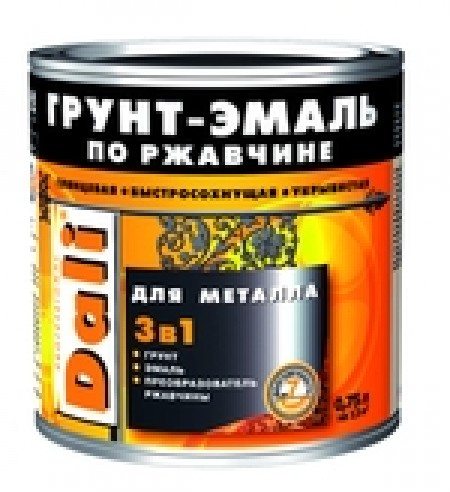

Rust enamel.
- Traditionally, red lead has been used to protect external pipelines from corrosion. This compound converts the iron oxide into a tough film, which provides reliable protection against rust.
- If you choose the right soil for pipes, then coating with various kinds of enamels will protect the surface for at least 5-7 years. Modern enamels are distinguished by their spectacular appearance and good resistance to atmospheric surprises. Moreover, if you apply several layers of paint, you will forget about this problem for many years.
- For internal surfaces, on cold pipes, you can safely use inexpensive oil paints. The only thing you should pay attention to is that this paintwork material is allowed to be used on metal.
Tip: if the amount of work is small and you want to do everything quickly with your own hands, you can purchase a special automotive primer for metal. This composition is sold in an aerosol package, has excellent characteristics, is sold at auto markets, but the price is decent.
Zinc paint.
Plastic pipes
- Painting polypropylene and plastic surfaces is a purely amateur business. Modern plastics are already quite strong and well protected. But some owners want to paint the pipes in order to improve the appearance and harmonize the interior.
- But the paint for polypropylene pipes must be selected separately. The fact is that the surface of the pipe is very smooth, has low adhesion, and not every compound will stick to it. The second problem can come up later, many paints can simply corrode the surface of the plastic, as a result, the pipe will collapse.
- The easiest way out is to use a special enamel, packaged in aerosol cans for plastic.Moreover, pay attention to the marking, some compositions do not require preliminary preparation and priming of the surface at all, but there are also those that lie only on the ground. By the way, the soil is also sold special for plastic.
- A good solution would be to purchase acrylic paints for working on plastic or metal. Acrylic compounds have almost the widest palette of colors, plus the paints are quite durable and effective. They are available for both external and internal finishing work.
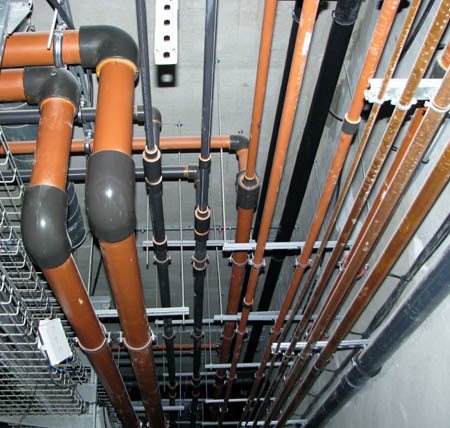

Plastic wiring.
Painting pipes inside and out or how to paint pipes correctly
Modern dwellings, among other things, consist of various engineering structures and communications, including: a gas pipeline, sewerage, water and heat supply, telephone and Internet networks.
Some of their components, such as pipes, may need protection against corrosion. To do this, it is best to paint them. Apart from a practical purpose, the paint will give the pipes a pleasant appearance.
The only condition for this operation is the ability to get to the pipes.
Perhaps, for residents of many houses and apartments, this problem is not relevant. Currently, water pipes are designed from metal-plastic and polypropylene.
Nevertheless, there are still a lot of iron pipes in operation, primarily located in summer cottages. It was from them that water pipes were installed for irrigation of crops in the plots.
Water supply pipes must be re-painted every spring. How to do this is described below.
Preparation for painting iron pipes
Before you start painting water pipes, you need to determine what they are made of. Also, their temperature is important for the choice of paint. In addition to paint and a brush, it will be impossible to do without sanding paper, gloves, rags, cuvettes and primer. If the pipes are covered with old paint, it must be removed.
After their surface is cleaned of it, it will need to be sanded. This removes rust. After that, the surface of the pipes is degreased. Then all the garbage is removed, and fresh air is allowed into the room. Only after all this does the coloring begin.
To prevent paint from dripping onto the floor, hold the brush over a container.
Where to start coloring?
A pipe that is easily accessible is much easier to paint than one that is difficult to approach. This applies to risers and radiators. It should be painted, starting from the top and moving downward. It is important not to leave unpainted areas on the surface. The second layer should be painted when the previous layer is dry.
Plastic pipes are prepared differently for painting. After washing with warm water, they are allowed to dry. Oil or water-based paints are best suited for them. What color of the wall, the same should be the pipe.
How to paint black pipes?
The most susceptible to corrosion are communication pipes made of ferrous metals - steel and cast iron. In order to protect them from possible destruction and extend their service life, they should be painted. And before that, carry out thorough preparation: wipe off the dust and clean out the rust.
It is important that the paint is applied to a dry surface. Cast iron and steel pipes are best painted with enamel, which includes a rust converter, a primer with anti-corrosion functions and the enamel itself, which has high wear protection. It is necessary to paint over the pipe surface well using two layers.
How to paint a sewer pipe?
Recently, plastics have been used in the manufacture of sewer networks. And this material does not need the protective functions of paint. So you can paint only a metal line to give the protruding pipe a decent look.
As you know, paints exist for all surfaces, and even for plastics.To purchase the desired paint and varnish product, you need to find out what the pipe is made of (this should be written on it), and what, in the opinion of a specialist, paint is recommended for it. Play it safe by reading the paint can label.
If the pipe is metal, but still not so simple. Rather, it will be easy to paint it, but it is problematic to prepare it for painting. This is due to the fact that some of the sewer networks are within sight, and some are reliably hidden.
In this case, a construction hairdryer can help. With its help, the cleaned surfaces that are in the public domain will be dried. The paint should be chosen so that it can withstand high temperature and humidity (important for bathrooms).
How to calculate the color of pipes?
It is quite difficult to immediately figure out how much paint you need to buy for pipes. After all, its consumption is calculated in square meters on a flat surface. The following knowledge can help in calculating the amount of paint:
- A lot of paint is wasted when you have to paint in hard-to-reach places. Because small strokes obviously consume more paint. The first coat takes up more paint than the next. A smooth surface absorbs paint less than an uneven one.
- You also need to remember that a hot pipe dries faster than a cold one. The same thing happens when painting it with spray paint.
Calculation of the amount of paint
How to calculate paint consumption for pipes of known length and diameter?
To begin with, any manufacturer indicates on a can of paint an approximate consumption per square meter of surface when painting in one layer. Don't forget: we will most likely have two layers..
Thus, we need to calculate the surface area of the pipe in order to reduce the calculation to a simple math problem.
Let's remember the geometry: the surface area of a cylinder is equal to the product of its circumference (which, in turn, is equal to the product of its diameter and pi) by the height of the cylinder. In our case, the length of the pipe.
Therefore, the surface area of the pipe is equal to the product of its length and diameter and Pi.
Let us, as an example, calculate the color of pipes with enamel at a consumption of 300 grams / m2 per layer for a pipe length of 10 meters and an outer diameter of 20 millimeters.
The area of the pipe will be 10 * 0.02 * 3.14159265 = 0.62831853 m2.
The paint consumption for each layer will be 0.3 * 0.62831853 = 0.188495559 kg. We have two layers, so it will take approximately 0.376991118 kg.
The example is certainly contrived. With such a volume of coloring, no one will waste time on calculations, as well as calculate millionths of a gram. However, the calculation principle is also suitable for large pipelines.
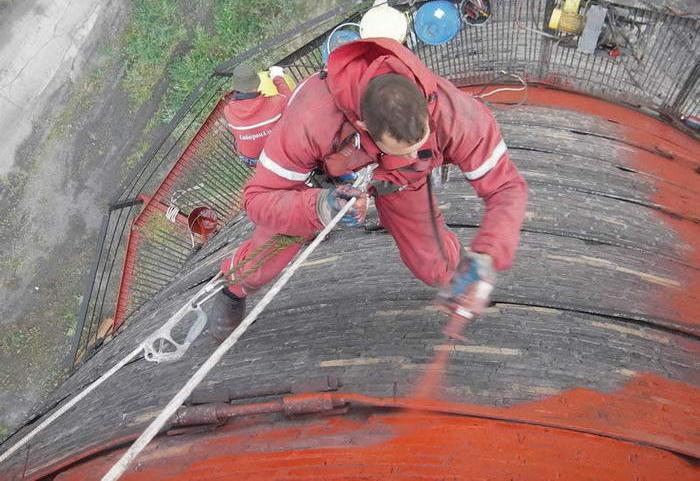

When painting this pipe, it is better to calculate the paint consumption in advance.
What material should be chosen
The material for painting is selected in accordance with the operational focus. To protect pipes for hot water supply or heating, it is necessary to choose a paint that protects well against corrosion, does not turn yellow and does not fall off under the influence of high temperatures. There is always a corresponding marking on the packaging of such paint. Pentaphthalic, alkyd, organosilicon enamels are best suited. You can use water-dispersion paints, having previously primed the pipe surface. Oil paint is not suitable for hot water pipes, it darkens quickly.
Pipe paint
Each type of paint has its own pros and cons. All of them are suitable for painting metal surfaces. Alkyd enamels provide a durable and homogeneous coating, they perfectly tolerate high temperatures, are resistant to mechanical stress and abrasion. The color palette is very wide. Among the disadvantages should be noted an unpleasant odor that will stay in the room for some time.To avoid the appearance of odor, it is better to paint with water-dispersion compositions. This coating dries very quickly. Acrylic enamels based on organic solvents will give the pipes a glossy shine. Painted surfaces will retain their original appearance for many years. But you will have to endure the smell of solvents for some time.
Cold water pipes are often covered with condensation, therefore, the material for the coating must be selected taking this fact into account.
When choosing a material, one should take into account not only the characteristics of the paint itself, but also adhesion, that is, the quality of its adhesion to the metal surface. It should be applied evenly, without gaps. It is unacceptable to leave remnants of the old coating, foci of corrosion. In these places, the new coating will peel off very quickly. It is even possible to develop corrosion under the paint layer, but outwardly everything will look good.
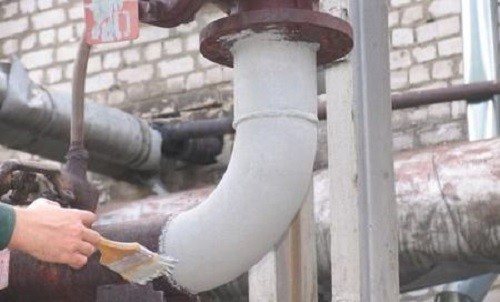

Gas pipe painting


